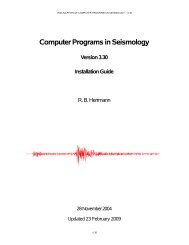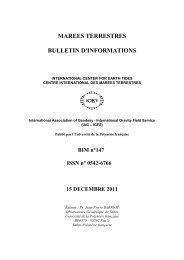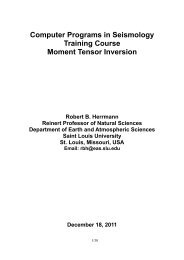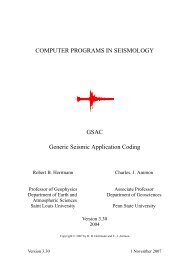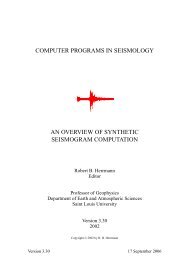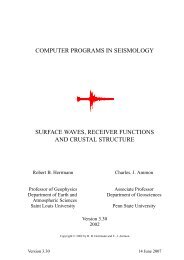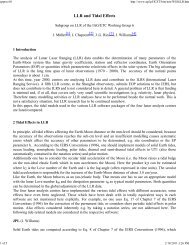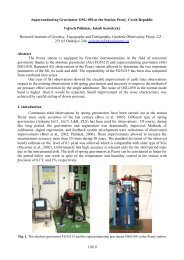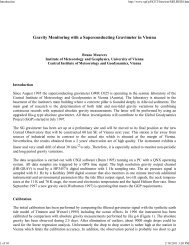3.04 Gravimetric Methods – Superconducting Gravity Meters
3.04 Gravimetric Methods – Superconducting Gravity Meters
3.04 Gravimetric Methods – Superconducting Gravity Meters
Create successful ePaper yourself
Turn your PDF publications into a flip-book with our unique Google optimized e-Paper software.
82 <strong>Superconducting</strong> <strong>Gravity</strong> <strong>Meters</strong><br />
hidden problems that need to be fixed. We call the<br />
residual gravity g (temp):<br />
where<br />
g ðtempÞ ¼g ðobservedÞ <strong>–</strong> g ðremovedÞ<br />
g ðremovedÞ ¼g ðtidesÞþg ðnominal pressureÞ<br />
þ g ðdriftÞþg ðpolar motionÞ<br />
½2aŠ<br />
½2bŠ<br />
The instrument calibration factor already enters eqn<br />
[2]. Note that a linear function is normally used to fill<br />
in a residual gap, so we are interested only in modeling<br />
signals that are not linear during a gap. Polar<br />
motion is very well defined by IERS data, but at a<br />
level of 5 mGal yr 1 (or 0.01 mGal day 1 ) it is not<br />
important for gaps of less than a week or so.<br />
Instrument drift over the time period of most gaps<br />
can usually be taken as a simple linear function of<br />
time. Other components of the signal such as hydrology<br />
or nontidal ocean loading are, however, too<br />
complex to be included as part of the removed function,<br />
even though they can have an effect of several<br />
mGal over time spans of days.<br />
Figure 8(c) shows g (temp) for the case when g<br />
(removed) consists of a local tide model and a nominal<br />
pressure correction. All the short spikes were<br />
previously replaced by a simple linear interpolation<br />
on the original data, as discussed above. Because the<br />
pressure is included in the g (removed) model, it is<br />
corrected before the gravity in order to avoid introducing<br />
spurious signals in the gravity. The gravity<br />
series still has a major problem between days 256<strong>–</strong><br />
258, but otherwise looks ‘better’.<br />
At ICET/GFZ, the basic files for all stations have<br />
uncorrected minute data of the form of Figures 8(a)<br />
and 8(b), that is, raw data decimated to 1 min but<br />
with no data repair prior to decimation. ICET produces<br />
corrected minute data in which data repair has<br />
been done on this already-decimated minute data.<br />
Some users also send data that have been repaired<br />
at the second sampling rate prior to decimation.<br />
<strong>3.04</strong>.2.1.5 Disturbances and offsets<br />
To make further progress, we now work with the<br />
residual series g (temp), as in Figure 8(c). The<br />
major disturbance at day 256 contains an offset and<br />
there is a suspicious signal at day 247 that requires<br />
consideration. Repairing (fixing) the offsets in<br />
Figure 8(c) is one of the most critical processing<br />
steps, requiring choices as to which problems to<br />
leave alone, and which to fix. We consider an offset<br />
(or tare) to be any apparent change in the instrument<br />
base level. This could be a small offset (0.5 mGal) that<br />
takes place within one time step (e.g., 1 s) due to an<br />
instrumental or electronic event. Alternatively, an<br />
offset may occur during helium refilling (maybe 10<strong>–</strong><br />
20 mGal) or a major electrical strike that causes level<br />
changes of 100 mGal or more.<br />
Here we choose to fill the gap between days 256<br />
and 258 with a straight line and to absorb the apparent<br />
level change into an offset that is 13.816 mGal. We<br />
have no means of knowing the actual offset during<br />
this time (the gap), so we simply join the good data<br />
before and after with a straight line and compute the<br />
offset needed to minimize the residual signal. This is<br />
a large offset that is clearly associated with something<br />
that happened to the instrument, involving also the<br />
pressure; the instrument base level was changed by a<br />
non-geophysical event. Unfortunately, the data log is<br />
unavailable for this time period at Boulder, but at<br />
most stations there should be a written explanation of<br />
such events (stored in the GGP database as ‘log’ files).<br />
Some disturbances will not cause an obvious offset in<br />
the data, but clear offsets should be removed.<br />
The ‘fixed’ residual is shown in Figure 8(d) (that<br />
interpolates the gap), but there is still an anomaly at<br />
day 247 with a jump of 2 mGal followed by a gradual<br />
decrease of 4 mGal. We know that rapid changes of<br />
gravity can be caused by physical processes such as<br />
heavy rainfall (Crossley and Xu, 1998; Klopping et al.,<br />
1995), but there is no reason at this point to adjust the<br />
data, even though the disturbance causes an apparent<br />
offset. Even though a log file helps to indicate a nongeophysical<br />
cause for an offset, it usually cannot help<br />
to decide what the size of a particular offset may be.<br />
After going through the whole year 1997, we find<br />
a total of 29 problems that need to be fixed, three of<br />
which were readily apparent offsets. The residual<br />
curve for the whole year is shown in Figure 8(e).<br />
Day 247 still shows up as a possible nonphysical<br />
anomaly, as there is no apparent subsequent recovery<br />
from the level jump. Without the ‘offset’, the data<br />
would show a smooth annual variation that arises<br />
predominantly from polar motion. Although it<br />
might be tempting to treat more aggressively the<br />
level change as an offset, doing so will affect all the<br />
subsequent data, and it is clearly risky to do so without<br />
good reason.<br />
<strong>3.04</strong>.2.1.6 Automatic procedures<br />
Ideally, each day’s raw data record should be scanned<br />
visually for potential disturbances. Where this is not<br />
possible, simple numerical algorithms can scan the<br />
data for the rapid detection of anomalies. One




